Where Do Coffee Beans Come From?
You love that little brown bean that energizes your morning.
But where do coffee beans come from? And how can this knowledge affect how you purchase coffee and how you prepare your brew?
Below we dive deeper into coffee cultivation and summarize why there isn’t one place your favorite bean comes from!
So…Where Do Coffee Beans Come From?
To trace the roots of coffee back to the beginning, we have to go to Africa. To be more specific, evidence points to Arabica coffee plants originating in Ethiopia. With tales of a goat herder who found his goats feeling rather, well, caffeinated after feasting on coffee plants.

Nowadays, there’s a good chance that the coffee in your cup wasn’t grown in Africa. In fact, many coffee drinkers have never heard of coffee from Africa. You might, however, have heard of coffee from other parts of the world, such as Brazil, Colombia, or perhaps Indonesia. There’s a reason for that.
These days, most coffee comes from the four major coffee-producing countries: Brazil, Vietnam, Colombia, or Indonesia. That explains why so many people have heard of beans grown in those countries.
Related Read: Coffee Growing Regions
How did coffee spread out from Africa to such diverse areas of the world?
Coffee was taken from Africa and first planted in the Middle East, then South East Asia, and then spread to other parts of the world.
Coffee has to be grown in the area of the world known as the coffee belt. We don’t have time now to get into the whole history here but check out this history of coffee article to get the full backstory.
Types Of Coffee Plants
There are two major types of coffee plants, or coffee species, that account for virtually all coffee grown around the globe: Arabica and Robusta.
These coffee plant varieties look like a shrub, somewhat like a berry bush, with dark green leaves and distinctive round or oval cherries.
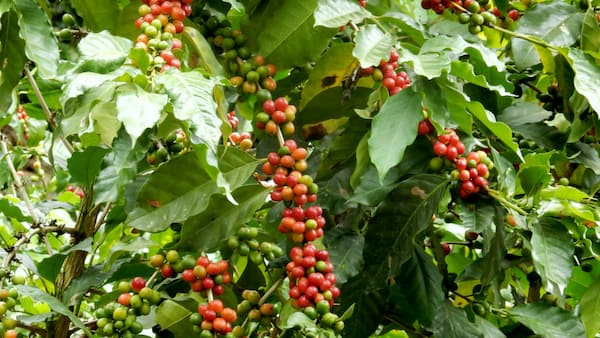
Robusta
Robusta. Coffea canephora, or Robusta coffee as it’s commonly called, is the coffee plant you probably haven’t heard much about. There’s a reason for that. But first, let’s talk about why people like Robusta.
Coffea canephora, or Robusta coffee, is prized for being hardy and resistant. That’s where Robusta coffee got its common name since it’s a robust plant that can stand up to higher temperatures and drought.
Although more and more specialty coffee is being produced from Robusta beans, it’s still mainly used in blends to impart body. Robusta beans fall short in the flavor category, having flat or even medicinal tastes. It’s not something to brag about on your bag of coffee, so most roasters don’t mention the Robusta beans tucked away in their blend.
Robusta also adds an extra kick of caffeine, higher than Arabica beans.
Arabica
Arabica Varietals. Coffea arabica makes up the majority of coffee produced and consumed. Arabica beans are especially valued for their complex aromas and flavors. Arabica coffee also has less caffeine than other types. Most specialty coffee, or higher quality coffee, is from this variety.
You can go even further with Coffea arabica and get into varieties. You’ll often see varieties such as Typica or Bourbon on the labels of coffee bags. Many varieties of Arabica coffee will change the flavors in the cup. As you try diverse types of Arabica beans, keep track of the ones you like.
Other Varietals
There are other types of coffee that are not as common. Don’t be surprised to see more Liberica or Excelsa beans in the future, as those types of coffee beans are hardier than the fragile Arabica and stand up to climate change.
The recently re-discovered Coffea stenophylla is another type of coffee plant to keep an eye on. This wild coffee once flourished in West Africa but was later forgotten.
It’s making a slow comeback, though, as an alternative to combating climate change. Learn more about it in the video below:
What part of the plant do coffee beans come from?
Now you know what part of the world your coffee may come from and what type of plant it grows on. Yet you may be asking yourself what part of coffee plants become that coffee bean you drink.
A coffee bean starts out life as a seed inside a fruit. That fruit is called a coffee cherry because it’s small, rather round, and often red when ripe. Once the fruit has ripened, the coffee cherry is picked and processed.
We’ll be talking more about that in a bit, but first, let me tell you more about how coffee plants are grown and how that affects the tastes in your cup.
How Is The Coffee Bean Grown?
A coffee plant generally starts out as a seedling grown in nurseries right on a coffee farm. Once the seedlings are strong enough to deal with direct sunlight, the farmer will plant them in their permanent place on the farm.
The ideal altitude for a coffee farm depends on the type of coffee. Robusta coffee does well at lower altitudes and higher temperatures, slightly below 2,000 feet above sea level. Arabica plants are a bit pickier and will only thrive at altitudes from 3,000 to about 6,000 feet above sea level.
A farmer has to be patient with a coffee plant. It can take 3 or 4 years to produce enough fruits for commercial use for a new coffee tree.
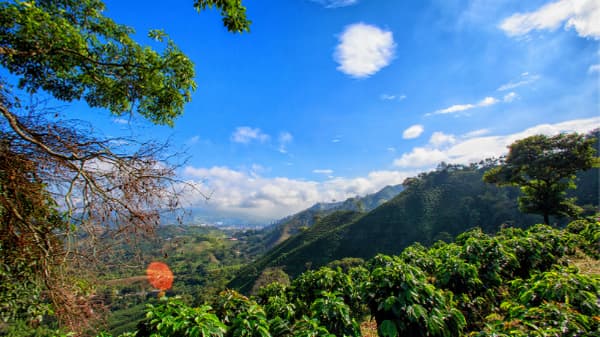
The cycle starts with the delicate white coffee flower. From each flower, a cherry will develop. Once the coffee plant flowers, it can take 7-9 months for the cherries to develop and ripen.
During this growing time, soil quality impacts the final flavors, body, and aroma in the roasted beans. That’s not surprising since a coffee plant gets its nourishment from the soil.
Volcanic soil gives plenty of nutrients for a coffee plant to be healthy and produce the best beans.
Rainfall also contributes to a healthy coffee plant and coffee cherry. Obviously, all plants need adequate moisture.
But in addition to that, rain clouds provide shade and relief from the penetrating tropical sun. The right amount of rain nurtures coffee plants, while too much will cause detrimental amounts of humidity and soil erosion.
Coffee is generally harvested once a year. However, there are microclimates where the rainfall patterns convince the plants to produce more often. There are even countries where harvest takes place a whopping three times every year.
How do you get coffee beans?
Once the coffee producer harvests the coffee from the plants, the real excitement begins. Now the farmers have to get that seed out of that fruit. How farmers do that changes everything, from sweetness to body to flavors.
Dry process
The oldest way to get that seed out of the fruit is simply to let the coffee cherries dry around the seeds, then peel the fruit off. A variation of that dry process is still used around the world.
The coffee cherries are harvested and left out on raised beds to dry. Once dried, farmers remove the fruit, and the seed is ready to be roasted.
Dry or natural process coffees will often taste fruity, since it absorbs flavors from the fruit pulp and the mucilage, which is a thin layer that covers the seed.
That can produce surprisingly strong tastes of berries or citrus. When done right, this kind of process can produce highly-prized coffees.
However, several things that can go wrong with the dry process.
If the environment is too wet, the fruit can rot before it dries, which can impart all sorts of unfavorable tastes to the seed. Coffee farmers have to rake and turn the drying coffee cherries often during several weeks to prevent those kinds of flavor-destroying mistakes.
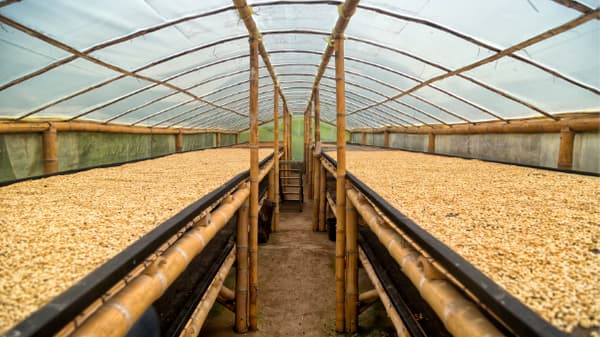
Wet process
Another way to process coffee is called the wet or washed process. The coffee cherries are put through a pulping machine that strips away the fruit right after the fruit is harvested.
Then the seeds are soaked in tanks of water for 12-24 hours, a resting period called coffee fermentation. During this time, the mucilage that I mentioned earlier dissolves into the water. Along the way, it imparts flavors to the seed we love!
In specialty coffees, at times, part of the mucilage is left on the seed. That sweet and tart layer gets absorbed into the beans.
Making this seemingly small change gives coffee entirely different flavors than a washed coffee, without the potential problems of a dry process coffee. It’s called honey process coffee, and it’s getting more and more common.
Independently of how it was processed, the coffee needs to dry to about 10% humidity. When the coffee is fully dried, though, there’s a surprise for people who aren’t used to seeing unroasted coffees.
The beans develop an outer papery layer that gives them a peanut-like look because of the light beige color. That papery layer, called parchment, is naturally occurring and protects the beans. Later, the parchment will be stripped off to prepare the beans for roasting.
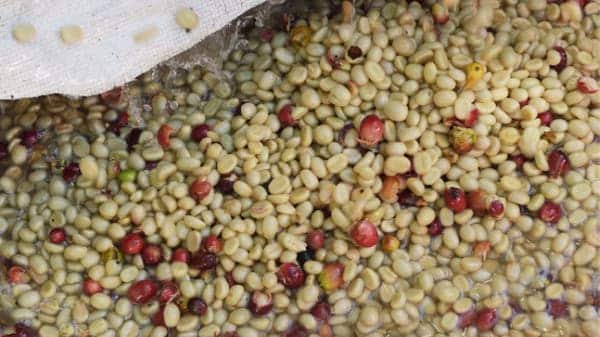
From Coffee Fields To Roast
A grower now has a dried coffee seed. This unroasted bean is called green coffee.
At this point, the grower will usually export the majority of their coffee beans to coffee-consuming countries like Europe and the United States. Green coffee beans come in jute sacks, generally 60 kg bags.
Frankly, this unroasted bean is not that pleasant. It’s grayish-green in color and a bit spongy to the touch. Unroasted coffee beans smell like peas and taste a bit like grass. It’s far from the brown goodness you get in a coffee bag.
Those flavors and aromas you love about coffee beans develop when the bean is roasted. Roasting coffee beans develops sugars, aroma compounds, and body.
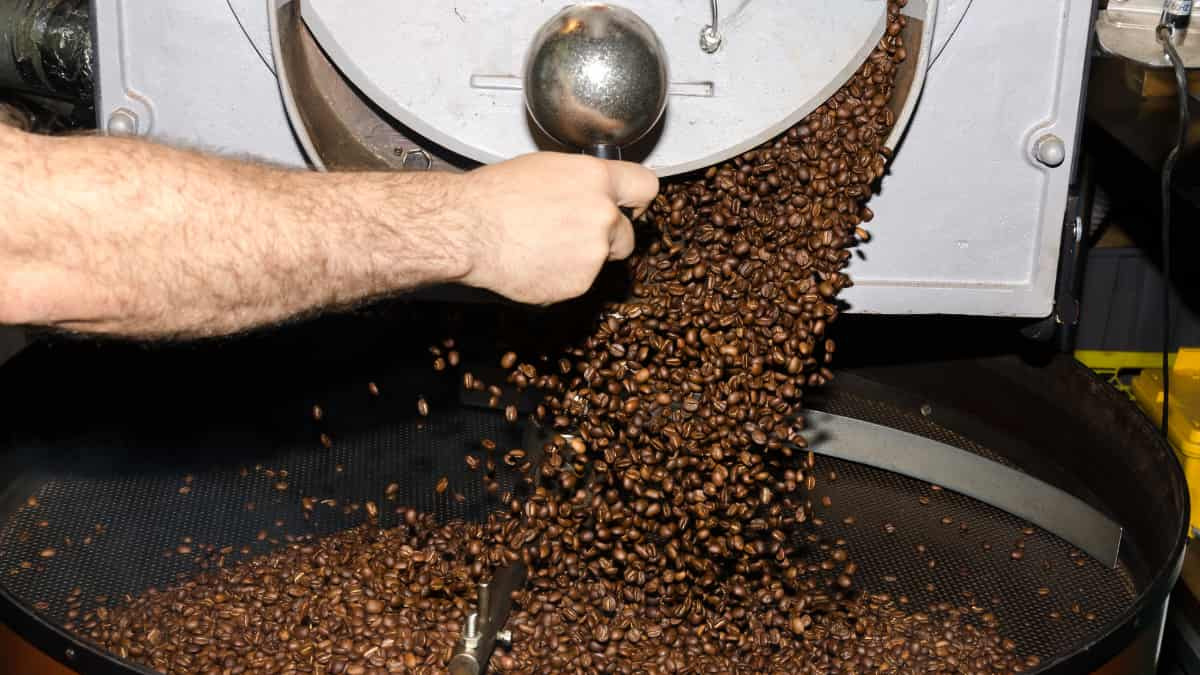
Coffee roasters use a special roasting machine that not only heats the coffee beans to the right temperature – around 550 degrees Fahrenheit – but also keeps them moving at all times to make sure they don’t burn.
When the internal temperature of the bean reaches a high enough temperature, coffee magic happens.
You start to smell the sugar in the coffee beans caramelizing, and you see them turning darker. At a certain point, the coffee beans literally start to crack, and you can hear the popping noise. Any time after this point, the coffee beans are considered to be roasted and can be brewed.
Although it might be difficult for you to roast coffee in a professional roastery, you can certainly learn how to roast coffee beans at home.
All you need is an appropriate heat source, unroasted coffee beans, and a bit of patience. The whole home roasting process will take less than 13 minutes.
Wrapping Up
That’s the plant-to-bean process for coffee.
You can see that the coffee species and the care a farmer takes in harvesting, processing, and drying coffee are all so important to the tastes in the cup. Then a master roaster crafts those beans and transforms them into the raw material for a delightful drink.

